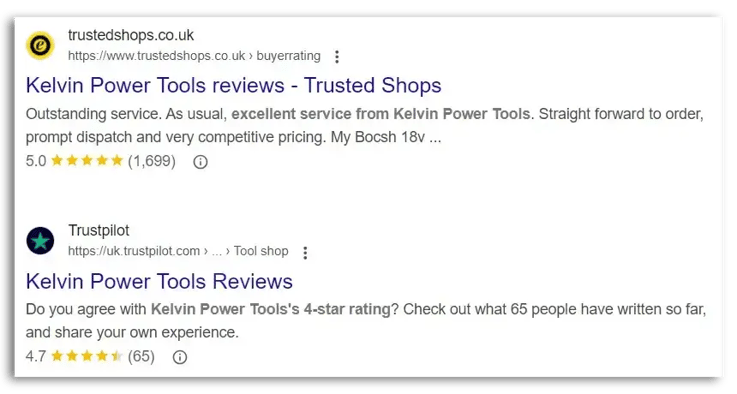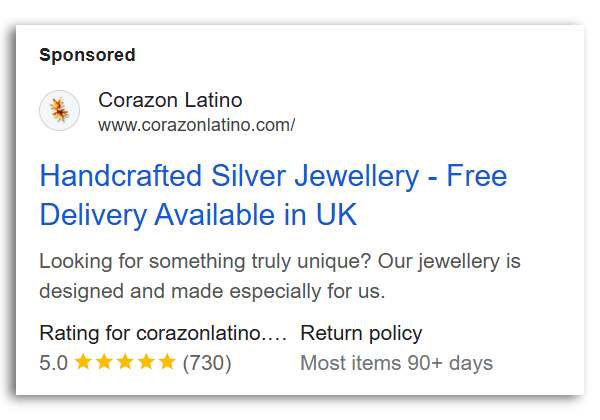SEO Tips for E-commerce: Improve Your Online Shop's Ranking in Google
SEO is an important tool for e-commerce businesses to bring in new customers. Here are the best tips for your online shop to rank higher in Google.

Getting your star ratings placed throughout Google can have a big impact on your brand. For starters, they help drive traffic to your site by drawing clicks. However, on a deeper level, these stars can build trust in your brand and confidence in your product before the user even visits your site.
Google has a lot of places to display stars on the results page of a typical search. Not all stars are created equally though, so we wanted to create a guide for you to get an understanding.
Contents of this article:
You can also download our whitepaper, which goes a bit deeper into the other Google platforms:
When it comes to visibility, Google is the place to be. Companies around the world have employees (and often entire teams) dedicated to search engine optimisation (SEO). Essentially, they work on techniques to rank individual website pages at the top of Google’s search results pages (SERPS) for the brand’s most important keywords.
For companies that struggle to rank at the top of the SERPs organically, Google offers advertisers the opportunity to “buy their way to the top” with Google Ads.
This Google result shows stars and ratings in a few places for The Croft House. Can you find them all?
(Click on the image to enlarge it)
In recent years, Google Shopping has also become more prominent in Google’s search results when a product search term is detected by the algorithm.
Getting on the first page for certain keywords is crucial to many businesses. However, even among those “chosen” to grace the top results, there is a battle for clicks. Companies fight for space on the results page like a piece of land during the California Gold Rush. Although gold may glitter, stars shine brightly too! And star ratings are a great way to win the battle of clicks in those Google SERPs.
There are a number of ways to draw a little extra attention to your page in the SERPs, including phone numbers, images, and more. However, nothing builds trust like those little yellow stars. Multiple studies have shown that stars in Google Ads (known as store ratings) can impact click-through rates from anywhere between 5-100% or more.
At no extra cost to your ads, it’s a no-brainer: do what you can to get those star ratings next to your site. Alongside store ratings, product ratings can have a similar effect on users when they are displayed in Google’s results.
Before continuing, it’s worth noting that it’s incredibly useful to have a Google Business Profile (formerly known as Google My Business) account as well as a Merchant Center account. Syncing your accounts across Google’s multiple platforms (including Google Ads) makes everything easier.
On top of that, it’s important to collect reviews with a Google reviews partner, like Trusted Shops. Google recognises these reviews as authentic, so if you want to display stars, make sure to use the right platform.
Without further ado, let’s get to the overview:
In this section, we’ll look at the different stars found on a typical Google search results page.
The user has typed a product-related search term into Google and pressed enter. The stars found here can be broken down into two categories: store ratings and product ratings. We’ll take a look at each type of rating and look at both the organic (free) and paid (ads) options.

Shutterstock/chainarong06
Store ratings are based on the average rating your business gets from service reviews (as opposed to product reviews).
Store ratings can be displayed in a number of ways in the Google SERPS. For example, Google may determine that the user is performing a product search based on the search terms entered (e.g. “Red sneakers”). If this is the case, Google Shopping results may appear at the top of the SERPs as a convenience to the user.
We won’t talk about the requirements for Google Shopping in this article. However, you can download our guide to getting star ratings displayed throughout the search engine giant, including Google Shopping & Google Maps.
With that in mind, let’s take a deeper dive into store ratings:
In the past, store ratings could only be displayed organically by third-party review providers. In October 2024, Google changed the rules (for English-language markets):
In some cases, Google will display a store rating directly next to the domain in question. The number of reviews (next to the rating) links to the Google "Store Page" where the user can dive deeper into a collection of reviews from Google and/or its partners (like Trusted Shops).

On the left, the first result is the Kelvin Power Tools website with a star rating directly below it. Clicking on the number of reviews leads to the Google Store Page (right).
In addition to this, third-party review providers (like Trusted Shops) can also show these star ratings in the search results on the shop’s behalf. Remember, this is still standard practice for Google in international markets.

When users search “your company name + reviews”, there’s a good chance that multiple review platforms appear in the SERPs displaying your ratings (like in the image above). Having a consistent rating is important for your online reputation because showing a really high rating on one platform while showing a low rating on another one can be a red flag to some consumers.
Recommended reading:
Why Do My Google Stars Not Appear?
The Trusted Shops Reputation Manager is an invaluable tool for helping you maintain your store ratings across multiple popular review platforms. You can, for example, disperse your review requests among Trusted Shops, Google Reviews, and Trustpilot (even if you’re not a member!).
Google Ads can have a great impact on your SEA efforts.
Google has never had any kind of restriction regarding the displaying of your store rating in Google Ads. Here is an example from Corazon Latino below:

Once again, syncing your Google Business Profile with your Google Ads account is helpful here.
In addition to the requirements listed for organic SERPs above, there are a few more requirements for displaying store ratings in Google Ads:
Product ratings are based on the average rating of the product reviews collected for a specific item. They can also be seen in both organic and paid ones.
As far as product ratings go, syncing your Merchant Center account with your Google Ads account is quite helpful here.
It’s worth noting that product ratings only appear organically in the traditional Google SERPs. Paid product ratings, however, can be seen in the Google Shopping results when they appear at the top of the results page. While Google Shopping ads can display product ratings, traditional Google Ads found in the SERPs do not show product ratings, only store ratings.
Since the Google Shopping results featured in the SERPs are paid ads, let’s focus on the product ratings found in the traditional results list.

Source: Alpinetrek
Product ratings can appear next to your unique domain in the results. As multiple vendors’ product pages will most likely appear in the results, this is where you really want to grab the user’s attention with your product page’s star ratings.
Even if you’re not in the first position, being the only vendor with product ratings can improve your odds of winning that valuable click.
To ensure both product reviews as well service reviews are sent to Google automatically, Trusted Shops has developed the Google Integration tool. With it, you can feel safe that Google is up to date with your company’s latest product ratings, thereby increasing the chances that your star ratings appear in your Google Ads and Google Shopping campaigns.
Recommended reading:
What Is Trusted Shops and How Can It Benefit My Business?
Google stars also appear on other popular platforms throughout Google. Once again, for many of these other platforms, having your Merchant Center and Google Business Profile synced with your Google Ads account is helpful in many of these cases.
Some other popular Google platforms and areas that display star ratings from customer reviews include:
Our whitepaper covers these remaining topics and also summarises the Google SERPS, which were covered in this article as well. Make sure to download it now:
Star ratings are found across Google, particularly in the search results of common user searches. They are based on the customer reviews you collect from Google review partners and have different requirements for displaying them. Make sure you’re on top of your game so you can win the battle for clicks over your competitors.
01/05/24SEO is an important tool for e-commerce businesses to bring in new customers. Here are the best tips for your online shop to rank higher in Google.
Valentine's Day has grown in popularity across Europe. We're sharing some romantic statistics (redundant, right?) and look at 9 marketing tips for V-day.